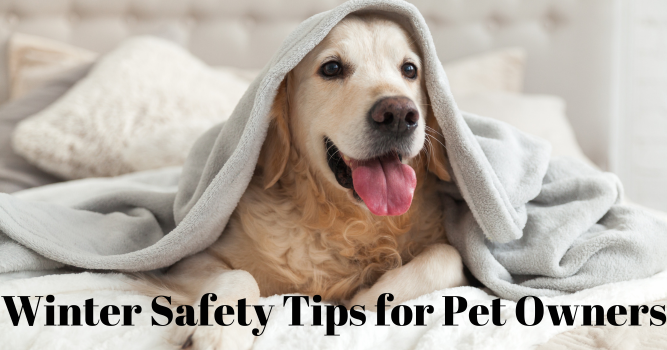Winter Safety Tips for Pet Owners: Keeping Your Furry Friends Cozy and Safe!
Winter is upon us, bringing colder temperatures and chilly winds. While we bundle up in cozy sweaters and sip hot cocoa, it’s important to remember that our furry companions need extra care during the colder months too. A good rule of thumb is this: if it’s too cold for you, it’s likely too cold for your pet.
Keeping pets warm in winter is essential for their health and overall well-being. This guide is dedicated to helping pet owners recognize signs of cold stress, understand the dangers of hypothermia, and take simple steps to keep their pets safe all season long.
Let’s make sure our pets enjoy the winter wonderland safely!

This blog post is dedicated to providing essential winter safety tips for pet owners. Let’s ensure our pets enjoy the winter wonderland just as much as we do, but safely!
Signs Your Pet Is Cold
Pets can’t tell us when they’re uncomfortable, so it’s important to watch for these warning signs:
Shivering:
Shivering is one of the most obvious signs your pet is cold. It’s an involuntary response to maintain body temperature and can be an early sign of hypothermia. If you notice shivering, bring your pet indoors immediately to warm up.
Whining or Anxious Behavior
If your pet seems more vocal, restless or anxious than usual, it might be due to the cold temperatures.
Hunching, Tucking or Curling Up
When pets hunch their bodies, tuck their tails, or curl into a tight ball, they’re trying to conserve heat and get as warm as possible.
Reluctance to Walk
If your pet hesitates or refuses to walk outside, the cold may be uncomfortable or painful for them.
Cold Ears and Body
Feel their ears and body; if they’re unusually cold, it’s a definite sign they are too cold, and it’s time to warm them up.
The Dangers of Hypothermia
Early symptoms include:
-
Intense shivering
-
Lethargy
-
Weakness or slowed reactions
More severe signs can include:
-
Stiff muscles
-
Shallow breathing
-
Collapse or coma
To prevent hypothermia:
-
Limit outdoor time during extreme cold
-
Keep pets dry and out of the wind
-
Provide warm, dry shelter
-
Use sweaters or coats for short-haired, senior, or small pe

Tips For Keeping Your Pets Warm
Keep Your Pets Indoors
The easiest way to keep your pets safe in to have them inside with you. Your pets will appreciate the warmth of being inside. If you don’t want them running free in your house, you can create a safe space for them in one area of the house.
Keep Them Dry
Wet pets get cold faster. Dry them off thoroughly after they’ve been outside.
Provide Warm Shelter
Ensure they have a cozy, dry, draft-free place to sleep away from cold floors.
Limit Outdoor Time
During extreme cold, reduce the time your pet spends outside. Shorten walks and outdoor play during freezing temperatures.
Consider Clothing
Some pets are not fond of wearing a sweater/jacket but others love being snug in their coat. A sweater or coat can be necessary for pets with short hair during the colder months.
Watch for Signs
Knowing the early signs of hypothermia can help you act quickly.
A few extra steps can ensure your pet stays warm and toasty.

Cozy Bedding
Invest in warm, comfortable bedding. Elevate beds off cold floors if possible.
Heating Pads
Heated pet beds or safe heating pads can add extra warmth.
Indoor Play
Keep them active indoors with toys and games.
Proper Nutrition
A well-fed pet is better equipped to handle the cold.
Regular Vet Checks
Regular check-ups ensure your pet is healthy and ready for winter.
Top Safety Tips for Pet Owners This Winter
Finally, here are some essential tips for pet safety during winter walks and outings:
Use Reflective Gear
With shorter days, reflective collars or leashes enhance visibility.
Wipe Their Paws
This removes ice, salt, and chemicals that can be harmful if licked.
Avoid Frozen Water Bodies
Keep them away from ponds or lakes that might not be fully frozen.
Leash Your Pet
Snow and ice can mask familiar scents, increasing the risk of pets getting lost.
Check Their Paws
Look for signs of injury or cracked pads.
Beware of Antifreeze
It’s poisonous but has a sweet taste that attracts pets. Clean up spills immediately.
Stay Off Ice
Avoid walking on ice as it can be unpredictable and dangerous.
Update IDs and Microchips
In case your pet gets lost, updated information is crucial.
Dress Them Appropriately
If your pet is short-haired, consider a coat or sweater.
Remember, winter safety tips for pet owners are all about vigilance and preventive measures. By understanding the signs of cold stress, the dangers of hypothermia, and simple ways to keep your pet warm and safe, you can ensure your furry friend enjoys the winter wonderland just as much as you do!
Trusted Local Pet Sitting & Dog Walking This Winter
Winter pet care requires extra attention, experience, and reliability. Whether you need daily dog walking, vacation pet sitting, or in-home pet care while you’re at work, choosing a trusted local pet sitter ensures your pets stay safe, warm, and comfortable.
By recognizing cold stress signs and taking preventative steps, you can help your pets enjoy winter safely.
🐾 Looking for reliable pet sitting or dog walking near you?
We’re here to help—rain, snow, or shine.
